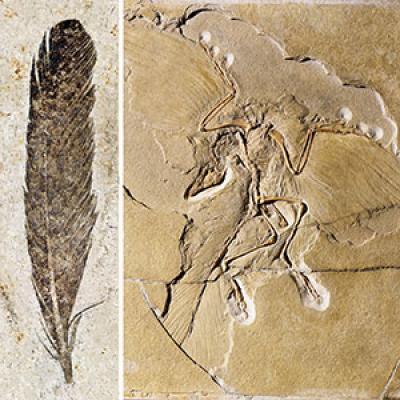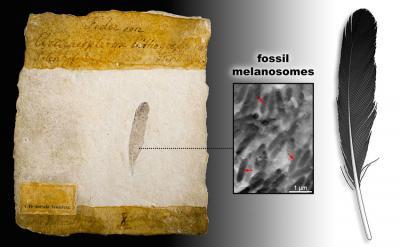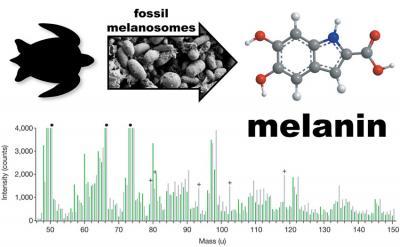Reconstructing ancient life has long required a certain amount of inference and imagination - especially speculative is the coloration of long-extinct organisms.
New methods of investigation are being incorporated into paleontology that may shed light (and color) on fossils.
Research presented at the recent Society of Vertebrate Paleontology meeting shows the importance of using new imaging technologies in reconstructing the color of Archaeopteryx, one of the most famous and important fossils species. Ryan Carney of Brown University incorporated scanning electron microscopy in a 2012 study to identify melanosomes (melanin-containing pigment structures) in modern feathers to reconstruct the feather color of the iconic Archaeopteryx, the so-called "missing link" -- or more appropriately, evolutionary intermediate -- between non-avian dinosaurs and birds. Archaeopteryx is a fossil taxon with great scientific, historical, and cultural importance.
However, Carney's interpretation was immediately disputed by two papers with alternative interpretations. The first was that the Archaeopteryx feather was both black and white, based on the distribution of organic sulfur imaged via synchrotron. The second was that the fossilized microbodies in the feather represent bacteria instead of melanosomes, given their similarities in size and shape.

The fossil feather and skeleton of the iconic dinosaur Archaeopteryx. Credit: Museum für Naturkunde Berlin
The results of Carney's new research address these alternative interpretations and provide new insights into the Archaeopteryx feather. "The inner vane of the Archaeopteryx feather, which they claimed was white, we instead found to be packed with black melanosomes," said Carney. "This is critical because white feather color is only produced in the absence of melanosomes."
Furthermore, Carney and Swedish colleagues have investigated the preservation of melanosomes in a variety of other fossils, utilizing additional new analytical methods such as Time-of-Flight Secondary Ion Mass Spectrometry (ToF-SIMS). Carney added, "We are not contending that every fossilized microbody is a melanosome. However, this new chemical method has allowed us to detect actual melanin molecules, which are associated with the melanosome-like microbodies in fossilized feathers and skin, from both terrestrial and marine environments. This integrated structural and direct chemical evidence provides the definitive proof that melanosomes can indeed be preserved in the fossil record."

Fossil feather imprints of melanosomes (pigment structures), and reconstruction of the matte black feather. Credit: Museum für Naturkunde Berlin/Ryan Carney
Together, this new research paints the final picture of the famous wing feather as matte black with a darker tip, coloration that would have provided structural advantages to the plumage during this early evolutionary stage of dinosaur flight.
The application of such high-sensitivity analytical techniques is ushering in a new age of paleontological investigations. What once was artistic license, such as the appearance of ancient organisms, is now revealing itself in living color. As analytical methods in paleontology keep a pulse on technological advancements, we will continue to gain understanding of how fossil animals once lived and looked.

From left to right: a fossil leatherback turtle andmelanosomes (pigment structures), whichcontain the 'molecular fingerprint' for melanin (bottom). Credit: Lindgren et al/Nature




Comments